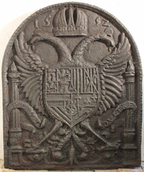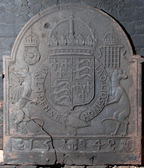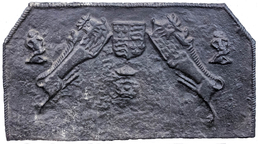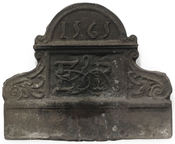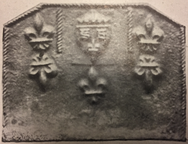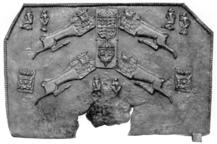-
145
Description: Arched shape; cavetto moulded edging; shield, crown, tassels and ribbons, of the combined kingdom of Castille, Aragon, Leon and Sicily.
Notes: Probably the arms of King Charles V of Spain; quarterly (1 & 4) Castille and Leon, (2 & 3) Aragon and Aragon-Sicily.
Inscription: 15 [?]0
Arms: Royal House of Trastámara (Spain)
- Decoration tags:
- rounded arched (shape)
- cavetto (edging)
- whole carved pattern
- armorial
- royal
Manufactured: in 1550 probably at Eisenschmitt Furnace in the Eifel area of Germany.
Current location: in private hands, Érezée, Luxembourg, Belgium.
- Attached to series:
- Foreign armorial firebacks
-
627
Description: Arched shape; cavetto moulded edge; double-headed eagle displayed, a Holy Roman Imperial crown above; in front, a quartered shield; a flaming pillar on each side, a motto scroll entwining each.
Notes: The shield bears the arms of Charles V, Holy Roman Emperor (reigned 1519-1556), king of Spain and nephew of Katherine of Aragon, Queen of England; the pillars are a symbolic representation of the Pillars of Hercules at the Strait of Gibraltar. Some variants of this fireback have a different date (e.g. see no. 1267) or none at all.
Copies of this fireback are known.
Inscription: PLVS OVLTRE [Further Beyond]
Arms: Charles V, Holy Roman Emperor
- Decoration tags:
- rounded arched (shape)
- cavetto (edging)
- whole carved pattern
- individual numbers
- heraldic
- armorial
- royal
- text
Manufactured: in 1592 possibly in the Eifel area of Germany.
Current location: Ashbourne, Derbyshire, England.
- Attached to series:
- Foreign armorial firebacks
-
1163
Description: Arched; ogee edging; Tudor royal shield, garter, crown and supporters (dragon and greyhound); top left, crowned Tudor rose; top right, crowned portcullis (grid of 6).
Notes: There are several firebacks with the Tudor royal arms that were probably produced in the Spanish Netherlands, perhaps illustrating the association between England and Spain through the marriage of Henry VIII and Katherine of Aragon. The firebacks differ in several small details, such as the form and rotation of the Garter motto, the style of the crown, the positioning of the supporters in relation to the Garter, and the form and size of the crowned rose and portcullis.; the placement of the rose and crown and of the crown above the portcullis suggest that they are stamps impressed over the original moulded design before casting. Bonhams auction, Oxford, 19 Feb 2020, lot 292.
Inscription: HONI SOIT QVI MAL I PENSE
Arms: Tudor royal
- Decoration tags:
- rounded arched (shape)
- cyma reversa/ogee (edging)
- carved stamps
- whole carved pattern
- heraldic
- armorial
- text
- animals
Manufactured: in the mid-16th century possibly in the Wallonia area of Luxemburg.
Current location: not known.
- Attached to series:
- Tudor royal armorial firebacks
- Continental Tudor royal armorial firebacks
-
207
Description: Arched rectangular shape; ovolo-moulded edge; Tudor royal shield, crown, garter and supporters (dragon and greyhound). Crowned rose on left, and crowned portcullis (grid of 16) on right side of crown; the supporters stand on a horizontal fillet; date panel with ovolo-moulding on top, central putto face splitting two parts of date with faces of putti in profile at each end.
Notes: Arms are of Edward VI. A very clear casting, almost certainly from the original pattern. There are several firebacks with the Tudor royal arms that were probably produced in the Spanish Netherlands, perhaps illustrating the association between England and Spain through the marriage of Henry VIII and Katherine of Aragon. The firebacks differ in several small details, such as the form and rotation of the Garter motto, the style of the crown, the positioning of the supporters in relation to the Garter, and the form and size of the crowned rose and portcullis.
Copies of this fireback are known.
Inscription: HONI SOIT QVI MAL I PENSE / 15 48
Arms: Tudor royal Edward VI
- Decoration tags:
- rectangular with round arch (shape)
- fillet (edging)
- whole carved pattern
- planklines
- heraldic
- armorial
- royal
- text
Manufactured: in 1548 possibly at Eisenschmitt Furnace in the Eifel area of Germany.
Current location: Ockwells Manor, Cox Green, Berkshire, England.
Citation: Kippenberger, A. 1973, Die Kunst der Ofenplatten (Düsseldorf, Verlag Stahleisen), p. 107.
-
208
Description: Canted rectangle; twisted rope edging (top and sides); quasi-symmetrical arrangement of four fleurs-de-lys in star, top centre, two fleurs each side along top edge, single fleurs beneath outer top fleurs; short rope length in vertical and inverted 'V' shapes each side between top fleurs; ?dagger handle irregularly positioned centre left and right.
Notes: The style and shape of the fleurs-de-lys is unique to a particular series of firebacks, suggesting the same source; the 'V' shapes may have apotropaic significance. A sketch of this fireback c.1891 is in the collection of J. Starkie Gardner's sketch books at the Victoria and Albert Museum, Archive of Art and Design (AAD/2014/8); at the time of drawing it was stated to be in the ownership of one Simmons, a furniture dealer of Lewes.
- Decoration tags:
- rectangular with canted top corners (shape)
- rope (edging)
- simple stamps
- carved stamps
- heraldic
Manufactured: in the mid-16th century in the Weald area of England.
Current location: in private hands, Cox Green, Berkshire, England.
- Attached to series:
- Royal series
-
125
Description: Canted rectangle; twisted rope edging (top and sides); top centre, Tudor royal shield between lion passant guardant to right and lion passant guardant sinister to left, both diagonally placed; below, a crowned rose; to left and right, an 'imp' with arms down, facing left.
Notes: One of a large series incorporating royal heraldic stamps. Canterbury Auction Galleries sale, 29 Nov 2017, lot 939 (£300).
Copies of this fireback are known.
Arms: Tudor royal arms of England
- Decoration tags:
- rectangular with canted top corners (shape)
- rope (edging)
- carved stamps
- heraldic
- armorial
- animals
- humans
Manufactured: in the mid-16th century in the Weald area of England.
Current location: not known.
Citation: Lloyd, N., 1925, 'Domestic Ironwork I', Architectural Review, 58, pp. 58-67.
- Attached to series:
- Royal series
-
262
Description: Rectangular; twisted rope edging (top and sides); top centre, crowned Tudor royal shield (over-pressed) between a leopard passant guardant sinister (on the left) and a leopard passant (on the right); below, crowned shield bearing initials, KH, above a fleur-de-lys, between two crowned roses; below each leopard, a pair of 'imp' figures, the left of each with both arms lowered, the right its right arm raised; right top corner, a crowned rose; left top corner, and uncrowned rose.
Notes: One of the 'Royal' series. Christie's Interiors - Oak Edition, South Kensington (Sale 5369), 4 November 2008, lot 257 (£3,250).
Inscription: KH
Arms: Tudor Royal (prob. Henry VIII)
- Decoration tags:
- rectangular (shape)
- rope (edging)
- carved stamps
- heraldic
- armorial
- royal
- text
- animals
- objects
Manufactured: in the mid-16th century in the Weald area of England.
Current location: not known.
- Attached to series:
- Royal series
-
261
Description: Plain rectangular bottom panel with fillet on top; above, rectangular panel with fillet and ovolo-moulded edging, within which the initials, ER, ornately carved, intertwined with floral tendrils; on each side, a scrolled bracket with double fillet edging, enclosing [?] ears of corn; on top, a narrow cornich, with an arch above, scrolled at each end and with double fillet edging, enclosing the date, possibly formed of individual stamped letters.
Notes: The 'ER' initials should not be assumed to be those of Elizabeth I. Formerly at Ockwells Manor, Cox Green, Berkshire. Christie's auction 4 Nov 2008 lot 259 (£3,750).
Copies of this fireback are known.
Inscription: 1565 / ER
- Decoration tags:
- rectangular with round arch (shape)
- complex individual (edging)
- whole carved pattern
- individual numbers
- text
- plants
Manufactured: in 1565 in the Weald area of England.
Current location: not known.
- Attached to series:
- Personal firebacks
- Miscellaneous pattern firebacks
-
1197
Description: Canted rectangular shape; twisted rope edging (top and sides); top centre, over-pressed crowned shield stamp on a rectangular block, bearing initials KH in Lombardic lettering, above a fleur de lys, the whole between two short vertical lengths of twisted rope, on the outside of each are two fleurs-de-lys, vertically aligned, the lower ones inverted; below the shield, a fifth fleur-de-lys.
Notes: An arrangement of stamps found on a distinctive series of Tudor firebacks of probable Henrician date. Illustration from Christy 1908, who noted it at Riverhall, Wadhurst, Sussex.
- Decoration tags:
- rectangular with canted top corners (shape)
- rope (edging)
- carved stamps
- heraldic
Manufactured: in the mid-16th century in the Weald area of England.
Current location: not known.
- Attached to series:
- Royal series
-
267
Description: Rectangular; twisted rope edging (top and sides); top centre, crowned Tudor royal shield (over-pressed) between a leopard passant guardant sinister (on the left) and a leopard passant (on the right); below, crowned shield bearing initials, KH, above a fleur-de-lys, between two further leopards, styles as above; below the lower shield, two 'imp' figures, the left one with both arms lowered, the right with its right arm raised; outside each lower leopard, a crowned rose (over-pressed); each top corner, a pair of ‘imp’ figures styles as before.
Notes: One of the 'Royal' series. Illustration from Dawson 1903. Formerly in the collection of Dr C. Prince, of Crowborough, Sussex. Further deterioration at the bottom of the casting has caused some loss of metal.
Inscription: KH
Arms: Tudor royal arms of England
- Decoration tags:
- rectangular with canted top corners (shape)
- rope (edging)
- carved stamps
- heraldic
- armorial
- animals
- humans
- plants
Manufactured: in the mid-16th century in the Weald area of England.
Current location: Leeds Castle, Leeds, Kent, England.
Citation: Balcomb, J. T., Nov. 1886, 'An Extinct Sussex Art', The Art Journal, pp. 337-340.
Citation: Dawson, C., 1903, 'Sussex Iron Work and Pottery', Sussex Archaeological Collections, 46, pp. 1-54.
Citation: Gardner, J. S., 1898, 'Iron Casting in the Weald', Archaeologia, 56, 1, pp. 133-164.
- Attached to series:
- Royal series

